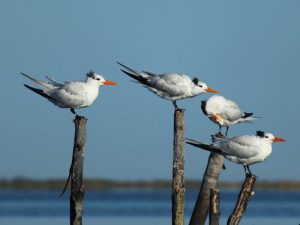 Along Virginia’s Eastern Shore, thousands of acres of coastal bays, shallow flats and small creeks feed into the Atlantic Ocean. As these estuaries flow towards the Atlantic, they carry baitfish and other food sources which attract a wide range of larger fish species.
Along Virginia’s Eastern Shore, thousands of acres of coastal bays, shallow flats and small creeks feed into the Atlantic Ocean. As these estuaries flow towards the Atlantic, they carry baitfish and other food sources which attract a wide range of larger fish species.
Understanding tides and knowing their cycles is essential when fishing these tidal environments. In most areas, fish feed based on tidal flow, moving in order to ambush baitfish and other prey.
Often coastal creeks form exaggerated curves along their path. The pattern of turns and straight sections form important structures. When water flows in a straight narrow path, the section acts like a funnel, causing tidal water to rush thru considerably stronger than in other parts of the creek.
Sharp bends in creeks are important areas to investigate. During tidal flow, currents race around the curves, creating rips and other areas where water mixes or collides. On the extreme outside of these hair pin curves, steep edges may rise abruptly to shallow areas where little or no tidal movement occurs. These areas offer protection for baitfish and other food sources. Channel edges along these flats can be productive areas to fish for flounder, bluefish, seatrout, croakers, small sharks and other species.
Eddies in tidal creeks and inlets can be excellent places to fish. In some areas, eddies form during running tides, trapping baitfish and crustaceans. Casting, jigging or pitching live baits into the opposing currents can be effective for catching flounder, striped bass, bluefish, gray trout, drum, cobia, or other fish that prey on smaller fish.
In coastal bays, accessible areas near mud flats and grass beds can be good spots to fish. These areas offer spawning habitat as well as nursery environments for young fish. Adult fish move in and out of these areas in spring to spawn and may also lurk nearby waiting for young fish or crabs to stray out of protected areas.
Kayak fishermen can sometimes reach more shallow water habitat than power boaters. Most coastal creeks and bays have small coves, marshes or other areas that are shallow and full of obstructions. Although these areas present some challenges to reach, they can hold incredible numbers of fish.